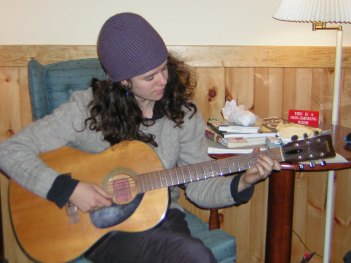In 1873, the QWERTY keyboard was invented by Christopher Sholes and put to use with Remington Typewriters. It was specially designed as to allow fast typing without the keys getting jammed. It was also designed to create a partnership between the machine and the typist, allowing the typewriter to become more of a tool than a mere object. It inspired the typist to have a certain rhythm when typing. This keyboard became standard even when keys jamming was no longer an issue because of computers (Laue).
Now, iPads and other tablets are becoming increasingly popular. The problem is that it is hard to type on a touch screen using the QWERTY keyboard. Enter Dr. Per Ola Kristensson, who realized that “QWERTY keyboards had trapped users in ‘suboptimal text entry interfaces’” and created a new one, the KALQ (BBC). The keyboard is specially designed to be used for “thumb typing”, that is, having to type with one’s thumbs while holding onto the smart phone or tablet. The research team at St. Andrews “used ‘computational optimisation techniques’ to identify which [order of keys] gave the best performance” (BBC). The research showed that the average person typing on a touchscreen with the QWERTY had “a rate of 20 words per minute” while the average typist using the KALQ keyboard has a rate of “37 words per minute”. Dr. Kristensson believes that this higher rate is enough incentive to convince users to switch keyboards.
This time around, I think it will be easier for people to switch keyboards because, unlike with a typewriter which was the issue with the Dvorak keyboard, one doesn’t need to buy a whole new machine. It would be very easy to just download this onto a tablet and spend a few days getting used to it.
An IPhone for a Folkie

a room at Indian Neck Folk Festival
I remember being at a folk festival awhile back. I’d walk through the giant main building, serpentining through groups of singers an musicians. People would share songs and take turns choosing what to play next. It was all just good fun. There were always, of course, the times when someone would forget a verse, forget the chord progressions, or two people would know different versions of a song. It was always entertaining to see how these situations panned out. Would they simply skip the forgotten verse or make up a new one? Would the melody be improvised or a harmony take over? What would settle the fight over whose version was correct?
Then came the iPhone. Now, when a Folkie forgets something (as many due) it’s no longer “I think it goes a little like this”. Instead you hear, “ Oh let me just pull it up on my iPhone. Yes, see, the capo goes on the fourth fret”. The spontaneity is gone, the creativity is spoiled, and memories are even more out of shape. There are some good things about the iPhone, though. It’s portable and easy to use so it’s great for recording these spontaneous jam sessions or special performances. The singers at the Nelson Solstice Concert used iPhone footage to promote their future events. It’s interesting how the iPhone and just quick internet access in general has altered the folk community, but I don’t think it has quite taken over, and I hope it stays that way.
My Friends Friends Are My Friends
In Friends, Friendsters, and Myspace Top 8, Danah Boyd discusses the predictions and outcomes of a few different social media sites. For example, “Friendster expected these users to list their actual friends” but what ended up really happening, like with Myspace and Facebook, is that people friended people they hardly knew, didn’t know at all, or even pages that weren’t people at all, but rather products or TV shows (Boyd, pg. 1).
Boyd goes into detail on every aspect of social media, bridging on the unnecessary. I’m guessing that this article is meant for those of us who never had a Facebook or Myspace page. The section I liked particularly well was the one on who to “Friend” and who to not. Do I “Friend” my professor, my employer, the campers I counsel who aren’t even old enough to have a Facebook? It’s interesting when Boyd points out the way social media sites have worked their way into our daily lives: the “Top 8” being used as leverage, friending someone because it’s impolite not to.
Having a Facebook or Myspace page has become a necessity in this society. I personally hate having a Facebook page, but for a lot of people it works as a new way of staying connected. Instead of losing all those high school friends once you graduate, you can keep track of their whereabouts through their pages. This way you never lose anyone completely, but it’s not an effort to keep in touch. We’re even reminded when their birthdays are. So a question I have that Boyd never quite got to is; do social media sites help us to connect more with others or distance our selves from them?
Humans and Computation
In Human Computation: Charting the Growth of a Burgeoning Field, Alexander J. Quinn and Benjamin B. Bederson define the ways in which humans and computers currently interact, and look into the ways humans and computers could interact in the future.
Truth be told, though, I didn’t understand it. There was no flow to the writing. There were so many dead sections; just definition after definition. So I don’t know what to write about, except for to just re-iterate the main definition.
Human Computation means using humans instead of machines as tools to compute certain things. This is mainly used in cases where digital computers are not yet advanced enough to solve certain problems. However, this does not seem to involve creative human thinking. As Quinn and Bederson put it, human computation is only apparent in “a predetermined plan designed to solve a computational problem.” (pg 2). Therefor, “online discussions and creative activities” are rendered moot. But weren’t the means of solving computational problems once just as creative? It’s almost like saying that there is no art in computation, no creativity to solving problems. Where would digital computation be without creativity? Maybe it’s easier for these writers to think of these things in black and white, but personally, I think that focusing less on defining terms and more on what all this is about, seeing the art and inspiration in it all, would bring human computation, collective intelligence, crowdsourcing, and social computing to the next level.
A Game of Spoils
In Spoiling Survivor: The Anatomy of a Knowledge Community , Jenkins takes a deep look into the inner workings of an online “community” that exists with the soul purpose of spoiling the TV Show Survivor. “Spoiling” a TV show means revealing something about what is going to happen so that the surprise is ruined. It’s really interesting, though, that to the people who participate in spoiling, the show isn’t being ruined but the experience of it is actually being improved. Survivor Sucks is a website where spoilers go to post things they have figured out about the upcoming episode or season. It’s, as Jenkins puts it, a “collective intelligence” in that everyone contributes some sort of information and then they all brainstorm about possible outcomes (pg. 53). It’s almost like a real community in which people would get together to raise a barn or harvest a crop, except that this one is totally digital and no one’s life or livelihood depends on the outcome.
In these new, digital communities, things that used to be insignificant have now become important parts of people’s lives. Some spoilers actually spend an immense amount of time working together to stay ahead of the show. Sites like this have become the new communities, involving people from all over the globe. And it’s woe to those, like ChillOne, who threaten them.

